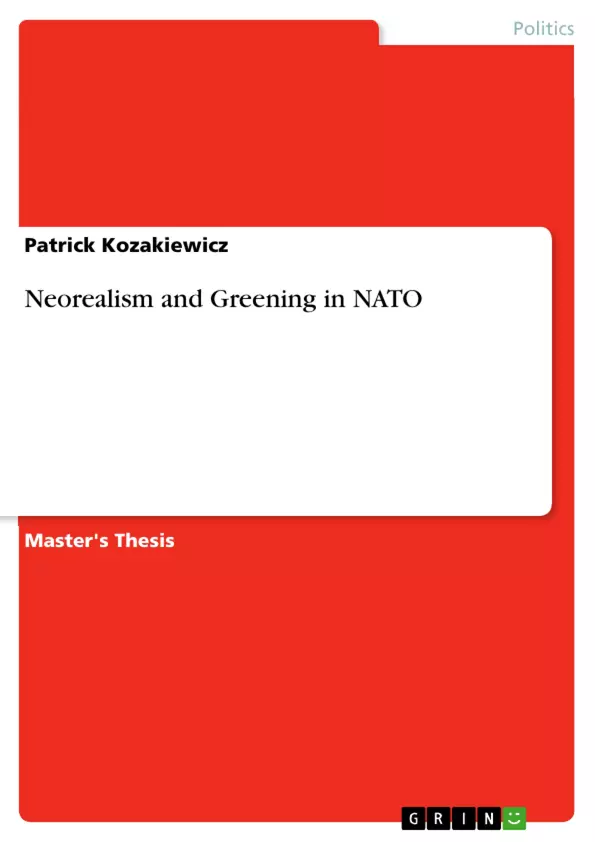The theory of Neorealism, elaborated by the Kenneth Waltz, makes a relevant point in outlining the political nature of military self-sufficiency and the greening process in NATO’s member’s militaries. As it has come to be known, greening with respect to energy security is on NATO’s agenda and very few studies try to understand the theoretical process of this issue. This thesis intends to fill this gap by analyzing the process of greening and energy security within NATO through the Neo-realism paradigm. Nonetheless, this thesis argues dimensions of energy conflicts, and calls attention to self-sufficiency and anarchical structures at the foundation of Neorealism. This thesis argues this particular example of NATO shows the benefits of Neorealism in understanding the military self-sufficiently and the greening process of NATO and ultimately calling for a more thorough and constructive need to develop this school of thought and the study of this case.
Inhaltsverzeichnis (Table of Contents)
- Chapter 1: Introduction
- Theoretical background
- Research questions
- Justification
- The choice of case
- Hypotheses
- Definitions
- Research strategy
- The choice of theory
- Chapter 2: Theoretical Framework
- The Roots of Neorealism
- Kenneth Waltz: The Father of Neo-Realism
- Balance of Power
- Neorealism, Cooperation and Alliances
- Methodological Approach
- Data sources
- Operationalization
- Expected Empirical Findings
- General neorealist predictions
- Specific neorealist predictions with regards to greening
- Chapter 3: NATO with respect to Energy
- Chapter 4: Greening
- The United States
- The United Kingdoms
- The European Union
- Turkey
- Chapter 5: Interpretation of Greening using Neorealism
- Chapter 6: Answers to Research Questions and Hypothesis
Zielsetzung und Themenschwerpunkte (Objectives and Key Themes)
This thesis examines the process of “greening” within NATO, specifically with regards to energy security, using the theoretical framework of Neorealism. The study aims to explore how this theory can help understand the military self-sufficiency of NATO member states and the implications of their greening efforts.
- The role of Neorealism in understanding military self-sufficiency and greening within NATO
- The relationship between energy security and greening policies within NATO member states
- The impact of anarchical structures on NATO's greening efforts
- The potential for cooperation and conflict within NATO related to greening policies
- The benefits of using Neorealism to analyze greening initiatives within NATO
Zusammenfassung der Kapitel (Chapter Summaries)
Chapter 1: The introduction discusses the importance of energy security in military strategy and outlines the gap in literature regarding NATO's greening efforts. It establishes the research questions, hypotheses, and methodology of the study, emphasizing the relevance of the neorealist perspective.
Chapter 2: This chapter explores the theoretical framework of Neorealism, tracing its roots back to Kenneth Waltz and highlighting key concepts like balance of power, self-sufficiency, and the role of anarchical structures in international relations. It also presents the specific predictions of Neorealism regarding greening initiatives.
Chapter 3: This chapter examines NATO's relationship with energy security, providing context for the analysis of greening efforts.
Chapter 4: The chapter delves into the greening policies of specific NATO member states, including the United States, the United Kingdom, the European Union, and Turkey.
Chapter 5: This chapter analyzes the greening policies of NATO member states through the lens of Neorealism, demonstrating the theory's applicability to this case study.
Chapter 6: This chapter presents answers to the research questions and discusses the validity of the hypotheses, drawing conclusions based on the analysis presented in previous chapters.
Schlüsselwörter (Keywords)
This study focuses on key concepts and themes like Neorealism, greening, energy security, military self-sufficiency, NATO, international relations, anarchical structures, balance of power, and the relationship between environmental and security issues. It also examines the individual greening policies of specific NATO member states, such as the United States, the United Kingdom, the European Union, and Turkey.
- Quote paper
- Patrick Kozakiewicz (Author), 2014, Neorealism and Greening in NATO, Munich, GRIN Verlag, https://www.grin.com/document/282100



